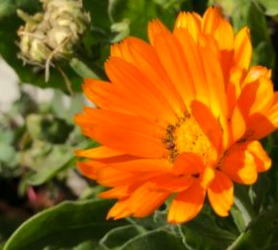According to folklore, calendula is associated with the sun and the fire element, and was once believed to imbue those in its company with the magical powers of protection and clairvoyance. Flowers hung above doorposts and placed under beds were thought to ward off evil and protect those sleeping. And it was rumored that to strengthen and comfort the heart, one should pick calendula under the noonday sun. What better way to celebrate the vernal equinox and beginning of spring than with this golden blossom?
Back in 1578, English botanist Henry Lyte wrote in A Niewe Herball that calendula “…hath pleasant, bright and shining yellow flowers, the which do close at the setting down of the sun, and do spread and open again at the sun rising.” And although the bright flower’s petals may currently be closed because we are experiencing (heavy) rain here today, that alone is cause for celebration: this sunny flower is thriving because of it! I’ve seen it popping up along sidewalks all over town recently. A well-known favorite herb, calendula has been used internally, topically, ceremonially and as a natural dye for centuries. 17th century botanist, herbalist and astrologist Nicholas Culpepper noted the use of calendula with vinegar as a rinse for the skin and scalp. He also mentioned that a tea made with the flowers was a comfort to the heart. In the Ayurvedic tradition of India, calendula is considered energetically cooling, while in Traditional Chinese Medicine (TCM) it is called Jin Zhan Ju and considered neutral and drying, used to support healthy skin. In North American indigenous cultures, it has been traditionally used to treat upset stomachs.
Our contemporary applications of the plant mirror its traditional uses. Calendula is an anti-inflammatory and anti-microbial that promotes the growth and healing of epithelial tissue. It is used internally and externally for ulcers, digestive inflammation, cuts, scrapes, boils, burns, insect bites, sunburn, diaper rash and dry skin. Use the freshly dried, whole flower heads to make infusions, teas and tinctures. And the fresh flower petals can add a nutritious dash of color and flavor to salads, spreads and other dishes. Naturalized in much of the world, calendula is native to Southern Europe, Egypt, the Mediterranean, and the region spanning the Canary Islands to Iran. It is one of the most essential herbs you can easily grow for your medicine chest. This bright orange and yellow annual easily re-seeds itself in your garden and just about anywhere, really. Be sure to choose Calendula officinalis and not one of the many ornamental marigolds (Tagetes spp.).
To grow, direct-sow in early spring or late fall (it can withstand some frost). It enjoys full sun or partial shade and moderate water. Flowers can be continually harvested—the hardy little plants produce all summer long—and the plants can be cut back drastically to increase new flower production. Because it grows like a weed here in on the central coast, it can also be foraged. Just make sure not to harvest from the side of the road or places where pesticides might be sprayed.
Calendula is an active ingredient in our First Aid Salve, along with plantain leaf and yarrow. And we love to infuse our gold-laden Celestial Body biodegradable shimmer oil with calendula for its sunny color and skin-soothing qualities.
Written by Liz Hodges of Verdant California

